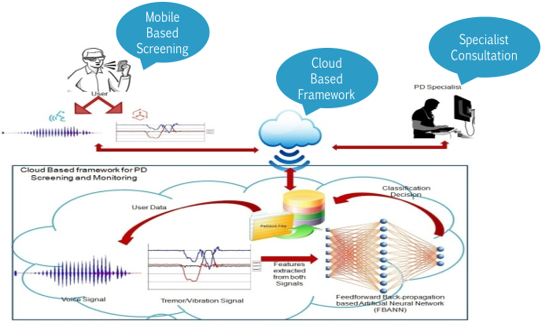PVDoctor
Cloud based Virtual Doctor for Parkinson’s Disease Screening and Monitoring


Parkinson Virtual Doctor, an AI enabled cloud-based system for Parkinson’s disease screening, risk assessment, referrals and follow-up to support physicians and beneficiaries forgetting timely intervention. Parkinson’s Disease (PD) is the second most severe neurodegenerative disease. Among the number of techniques, ‘voice disorder’ is a very common symptom for efficient PD detection. According to the severity of the disease, PD diagnosis and intervention are almost non-existent in developing countries, where resources are lacking. Therefore, in this paper, we are proposing a cloud based tool using mobile application, PVDoctor (Parkinson’s Virtual Doctor) to identify PD patients automatically by analyzing recorded voice using smart phones and create awareness for PD in developing countries.
Specifications
- Analyzes recorded voices and tremors to identify Parkinson’s Disease.
- Identifies voice disorders and hand tremors.
- Suitable for use in developing countries with limited medical services.
- Enables remote diagnosis by physicians and PD specialists.
- Simple testing by holding the phone and reading text.
- Alerts users of PD symptoms and provides nearby healthcare centers.
- Stores information for users without PD symptoms.
- Allows physicians to track and manage patient conditions.
Diagrams

Publications
M. T. Ehsan, S. I. Pranto and K. A. Mamun, "Real-Time Screening of Parkinson's Disease based on Speech Analysis using Smartphone," 2021 10th International IEEE/EMBS Conference on Neural Engineering (NER), Italy, 2021, pp. 573-576, doi: 10.1109/NER49283.2021.9441145. Published in: 2021 10th International IEEE/EMBS Conference on Neural Engineering (NER) Date of Conference: 04-06 May 2021 Date Added to IEEE Xplore: 02 June 2021 DOI: 10.1109/NER49283.2021.9441145 Publisher: IEEE Conference Location: Italy
Abstract
Speech disorder is one of the most dominant symptoms of Parkinson's disease. The speaking ability deteriorates as the disease progresses. However, regular screening and monitoring can improve the quality of living. Most of the patients in developing countries cannot access healthcare services due to a lack of facilities and costs. So a Cloud-based Smartphone application can be a cost-effective solution to this problem. This study aims to design and develop a tool for screening Parkinson's disease in real-time based on speech analysis. We adopted a machine learning-based approach for screening Parkinson's disease in real-time. This study applied several machine learning algorithms and found that the k-nearest neighbor algorithm performed better. Our model achieved 81.58% sensitivity, with 85.11% specificity in discriminating PD patients from healthy individuals using 10-fold stratified cross-validation. We tested our system in realtime and recruited 9 PD patients and 9 Healthy individuals, and recorded their voices for 10 seconds using our smartphone application. In real-time, we achieved 77.78% sensitivity with 33.33% specificity. Our study also demonstrated that Smartphone-based mobile applications could be a cost-effective solution for screening Parkinson's disease in real-time.
Sajal MSR, Ehsan MT, Vaidyanathan R, Wang S, Aziz T, Mamun KAA. Telemonitoring Parkinson's disease using machine learning by combining tremor and voice analysis. Brain Inform. 2020 Oct 22;7(1):12. doi: 10.1186/s40708-020-00113-1. PMID: 33090328; PMCID: PMC7579898.
Abstract
Background: With the growing number of the aged population, the number of Parkinson's disease (PD) affected people is also mounting. Unfortunately, due to insufficient resources and awareness in underdeveloped countries, proper and timely PD detection is highly challenged. Besides, all PD patients' symptoms are neither the same nor they all become pronounced at the same stage of the illness. Therefore, this work aims to combine more than one symptom (rest tremor and voice degradation) by collecting data remotely using smartphones and detect PD with the help of a cloud-based machine learning system for telemonitoring the PD patients in the developing countries.
Method: This proposed system receives rest tremor and vowel phonation data acquired by smartphones with built-in accelerometer and voice recorder sensors. The data are primarily collected from diagnosed PD patients and healthy people for building and optimizing machine learning models that exhibit higher performance. After that, data from newly suspected PD patients are collected, and the trained algorithms are evaluated to detect PD. Based on the majority-vote from those algorithms, PD-detected patients are connected with a nearby neurologist for consultation. Upon receiving patients' feedback after being diagnosed by the neurologist, the system may update the model by retraining using the latest data. Also, the system requests the detected patients periodically to upload new data to track their disease progress.
Result: The highest accuracy in PD detection using offline data was [Formula: see text] from voice data and [Formula: see text] from tremor data when used separately. In both cases, k-nearest neighbors (kNN) gave the highest accuracy over support vector machine (SVM) and naive Bayes (NB). The application of maximum relevance minimum redundancy (MRMR) feature selection method showed that by selecting different feature sets based on the patient's gender, we could improve the detection accuracy. This study's novelty is the application of ensemble averaging on the combined decisions generated from the analysis of voice and tremor data. The average accuracy of PD detection becomes [Formula: see text] when ensemble averaging was performed on majority-vote from kNN, SVM, and NB.
Md. Sakibur Rahman Sajal, Md. Tanvir Ehsan, Ravi Vaidyanathan, Shouyan Wang, Tipu Z. Aziz, Khondaker Abdullah Al Mamun, “UPDRS Label Assignment by Analyzing Accelerometer Sensor Data Collected from Conventional Smartphones. Brain Informatics 2020: 173-182, on 15 September 2020. Part of the book series: Lecture Notes in Computer Science ((LNAI,volume 12241)) First Online: 15 September 2020 pp 173–182
Abstract:
The study of the characteristics of hand tremors of the patients suffering from Parkinson’s disease (PD) offers an effective way to detect and assess the stage of the disease’s progression. During the semi-quantitative evaluation, neurologists label the PD patients with any of the (0–4) Unified Parkinson’s Diseases Rating Scale (UPDRS) score based on the intensity and prevalence of these tremors. This score can be bolstered by some other modes of assessment as like gait analysis to increase the reliability of PD detection. With the availability of conventional smartphones with a built-in accelerometer sensor, it is possible to acquire the 3-axes tremor and gait data very easily and analyze them by a trained algorithm. Thus we can remotely examine the PD patients from their homes and connect them to trained neurologists if required. The objective of this study was to investigate the usability of smartphones for assessing motor impairments (i.e. tremors and gait) that can be analyzed from accelerometer sensor data. We obtained 98.5% detection accuracy and 91% UPDRS labeling accuracy for 52 PD patients and 20 healthy subjects. The result of this study indicates a great promise for developing a remote system to detect, monitor, and prescribe PD patients over long distances. It will be a tremendous help for the older population in developing countries where access to a trained neurologist is very limited. Also, in a pandemic situation like COVID-19, patients from developed countries can be benefited from such a home-oriented PD detection and monitoring system.
Partners






